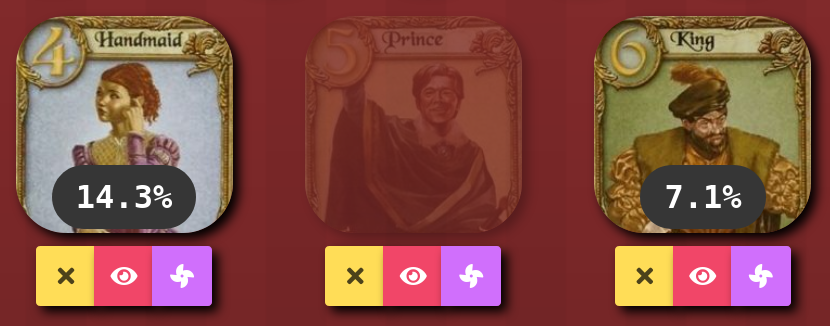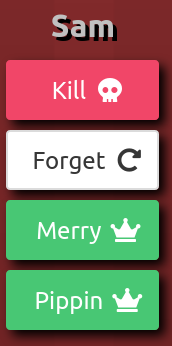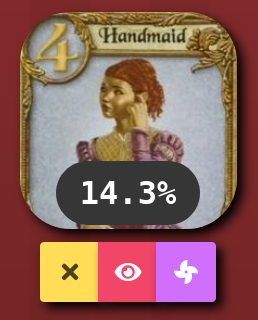The Love Letter Tracker
Are you in love with Love Letter, but tired of keeping track of all those pesky details about who has what? Me too! Enter: The Love Letter Tracker.
Usage
Note: The tracker is not Love Letter itself. It is meant to enhance, not replace, the original game. It works best on a computer screen or tablet. Also note that this tracker only targets the original 8-card version of Love Letter, which happens to be the version available digitally.
To begin, set the names of the Opponents you're playing with and hit Start.
The tracker displays the chance that each player has a particular card in their hand at the end of a given turn after they have made a play. The numbers you see are the chance of their single remaining card being one of the 8 possibilities.

Example: Handmaid is more likely than King here. There is no chance this opponent has the Prince.
This tracker is particularly useful due to its ability to persist knowledge across your opponents' turns. What they played this turn can affect what you learned about them last turn. This can result in some interesting deductions that are otherwise difficult for a human to notice!
Opponent Controls

This opponent, Sam, is playing against two others (and possibly also the user of the tracker).
- Kill: When an opponent is knocked out, this button removes them from the tracker until you hit
Reset Game. - Forget: Useful to undo misclicks, but also for clearing knowledge when somebody gets hit with a Prince.
- Opponent + Crown: This swaps what you know about two opponents, for when a King is played between them (and not the tracker user! See below.).

This particular view means that this opponent has a 14.3% chance of having a Handmaid in their hand.
- X: Mark that the opponent does not have this card. You would click this when you or some other opponent has a "Guard Miss" on someone.
- Eye: Mark that the opponent absolutely has a certain card. You would click this when:
- You saw with a Priest that they have a certain card.
- The user of the tracker is also playing, and a "Baron tie" occurred, since you know that they must have the same card as you.
- The user of the tracker is also playing, and gets King'd by an opponent.
- Flower: The "Baron button" (he's holding a rose, after all). Click this on the card that was revealed after a "Baron fight" on the row of the opponent who survived. Read that sentence again and nod to the computer screen that you understand.
Flow of Play

An opponents' card chances are affected by your knowledge of them as well as the remaining "unexposed" cards in hands, the deck, and "the hole".
A card should be considered exposed if:
- an opponent has played (or discarded) a card.
- the user of the tracker is also playing and has cards in their hand.
To "expose" a card manually, click it in the Unexposed Cards area. You will see it move to the other side. If you made a mistake, etc., you can reclick a card in the Exposed area to move it back. You will need to expose cards this way when:
- the tracker user gets new cards in their hand.
- the first three cards are discarded at the beginning of a two-player game.
To "expose" a card played or discarded by an opponent, click that card directly in their row. This has a direct effect on the "persisted knowledge" you have on them! Not doing so may result in incorrect probabilities being reported.
Note: Seeing a card with a Priest does not expose it. Don't click something out of the Unexposed area until it's truly played or in your hand. Further, if the tracker user gets King'd, they will have to manually return the stolen card the Unexposed area to fix the probabilities.
Otherwise, the tracker does not manage player turns. When you or an opponent plays a card, click the appropriate buttons as described above.
Have fun!
About
The Love Letter Tracker is written in Rust and compiled into Web Assembly. It utilizes the Seed Framework to handle user interaction and render the page. Overall layout is managed via CSS Grid and Flexbox, while general styling is provided by the Bulma CSS Framework.
If you notice a bug with the tracker, please report it. If you find the tracker useful, please consider donating.
Thanks to John, Sebastian, and Dan for their suggestions and help in testing.